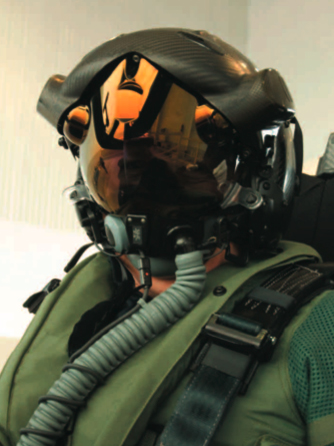Paris Air Show 2007
Thales Develops LX16 Tactical Data Link for Non-NATO Countries
Aviation Week & Space Technology
06/18/2007, page 114
Joris Janssen Lok
Paris
Link 16-equivalent data link gives nations option for tactical network
Printed headline: Non-NATO Network
Thales is proposing a tactical data link that gives nations not currently allowed to use the NATO-standard Link 16 the option to acquire a similar capability, which Thales calls LX16.
At least one Asian country is in negotiations to equip all of its armed forces (air, land and maritime) with LX16, say company sources, while declining to identify the customer.
Thales is also receiving "strong interest" in LX16 from several other nations as well as from "aircraft manufacturers who are not in NATO countries and who sell outside NATO."
"Non-NATO air customers often love to get a Link 16 capability, but they can't--so we developed an equivalent tactical data link that uses the same message set, grammar and vocabulary," says Patrice Caine, vice president for communications, navigation and identification activities in Thales Land & Joint Systems.
Once installed, the equipment behind LX16 can be modified "virtually overnight" to support Link 16 proper, Caine suggests. Such an upgrade could be considered if an LX16 user becomes eligible to join the Link 16 user community--for example, when there's a need to participate in Link 16 networks during coalition operations.
The change from an LX16 to a Link 16 configuration can be achieved by adding a MIDS-LVT (Multifunctional Information Distribution System-Low Volume Terminal) to each aircraft, ship or land asset that needs to participate in the Link 16 network.
Thales is also working to make LX16 interoperable with Link 16 without having to add MIDS-LVT terminals to all platforms. That would be a gateway system that allows the LX16 network to interface with Link 16.
According to Caine, "This gateway will basically be a MIDS-LVT and our new NextW@ve multifunction terminal placed together in a support aircraft such as a tanker or a transport aircraft. When airborne, the gateway-equipped aircraft would serve as the node in which the handshake between LX16 and Link 16 is made so that all participants in either network can exchange and share tactical information."
The gateway can also be installed on a naval vessel or in a land-based command center, as long as there is line-of-sight communication with the airborne network participants.
While Link 16 operates in the 960-1215-MHz. frequency range (L-band), Thales's LX16 operates at 300-600 MHz.
LX16 is based on Thales's new NextW@ve software-defined airborne radio technology. The NextW@ve multipurpose terminal, which weighs 6.5 kg. (14.3 lb.), was qualified at the end of 2006 and is now in series production, says Caine. It offers a 250-Kbps. secure mode (with growth potential to 500 Kbps.) and operates across the VHF/UHF frequency band between 30-600 MHz.
"The NextW@ve terminal does for LX16 what MIDS-LVT does for Link 16, except in a lower frequency range," he says.
The basic equipment is the same for both NATO and export programs, although the terminal's programmable security core would be different.
In the export configuration, the NextW@ve multi-purpose terminal (TRA 6036) would support both voice and data link communications. It would be integrated with a TSB 2525 combined interrogator/transponder (for identification friend or foe) and a national secure-mode crypto-computer. LX16 offers high electronic counter-countermeasures (ECCM) protection through a combination of frequency hopping and encryption, says Caine.
For NATO applications, the NextW@ve terminal (now called TRA 6034) would work with a MIDS-LVT unit (to support Link 16) in combination with a TSB 2521 interrogator/transponder and a Mode 4 crypto-computer.
As such, the NextW@ve terminal--sold, so far, to equip France's next batch of Rafale fighters, Morocco's upgraded Mirage F1s, and Boeing AH-64D Apaches in the United Arab Emirates--is at the heart of a new generation of Thales data links for air and joint operations.
According to Caine, these are designed to "generate and share the best common operational picture and to raise the operational tempo from sensor-to-shooter by speeding up the observe-orient-decide-act loop."
In a briefing at the company's Guyancourt plant outside Paris, Thales in addition to LX16 presented a new high-rate data link to downlink reconnaissance imagery to ground stations; and a close-air-support data link to improve communication and coordination between strike aircraft and joint terminal attack control (JTAC) teams on the ground.
The high-rate (more than 100 Mbps.) data link for airborne reconnaissance is a point-to-point, NATO-interoperable (Stanag 7085) downlink for imagery (synthetic aperture radar or electro-optical), video (infrared or TV) and/or plots (moving target indication or signals intelligence). It is usually combined with a two-way, omnidirectional, secure UHF-band service link to exchange control and management messages between the ground station and the sensor. The first application of this multi-payload data link technology is in the French air force and navy's Reco-NG airborne reconnaissance system (AW&ST May 7/14, p. 42). It has also been selected for the Neuron UCAV demonstrator program (led by Dassault Aviation) and for NATO's pending Alliance Ground Surveillance program.
For close air support (CAS), Caine hopes the French navy will order NextW@ve for integration into its Thales-supplied Damocles targeting pods. He says the CAS solution offered by Thales allows for the exchange of video and images (typically three compressed high-quality images per second at 100 Kbps.). It also supports the nine-line message format and voice coordination.











